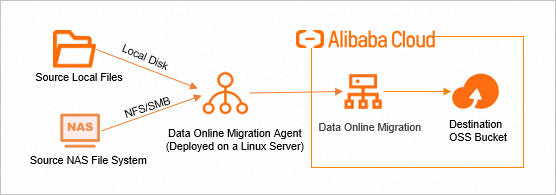This topic describes how to migrate data from local file systems to Alibaba Cloud Object Storage Service (OSS).
Overview
Alibaba Cloud Data Online Migration provides a data migration channel between different storage services. Data Online Migration can be used to migrate data from third-party storage services to OSS, between local file systems and OSS, between local file systems, or between OSS buckets.
To use Data Online Migration, you need to only log on to the Data Online Migration console, create a source data address and a destination data address, and then create a migration task. After the migration task starts, you can manage the task in the console. For example, you can view the progress and traffic information of the task.
Introduction to local file systems
Local file systems are classified into the following types:
File system that is deployed on a local computer to manage and store files on the local computer
File system that is mounted to a local computer, such as an File Storage NAS (NAS) or Google File System (GFS) file system
A local file system on the Linux operating system supports a variety of functions. The following table describes the common functions.
Function type | Description |
File I/O | A local file system supports Portable Operating System Interface (POSIX)-based file I/O functions such as |
Directory operation | A local file system supports directory operation functions such as |
File metadata | A local file system supports file metadata functions such as |
Memory mapping | A local file system allows you to use the |
File locking | A local file system allows you to use the |
File system cache | A local file system allows you to refresh data in the cache of the file system by using functions such as |
In addition to the preceding functions, functions such as file I/O vectoring functions (readv and writev), file system event function (inotify), and POSIX message queue functions (mq_open, mq_send, and mq_receive) are also supported by local file systems. The functions and features supported by a local file system vary with the type and version of the file system. Therefore, you must understand the file system that you use and select appropriate functions based on your business requirements.
Flowcharts
Migrate data
The following figure shows the process of migrating data from local file systems to OSS.

Create a migration task
The following figure shows the process of creating a migration task.
When you create a data address for a local file system, you must associate the data address with an agent.